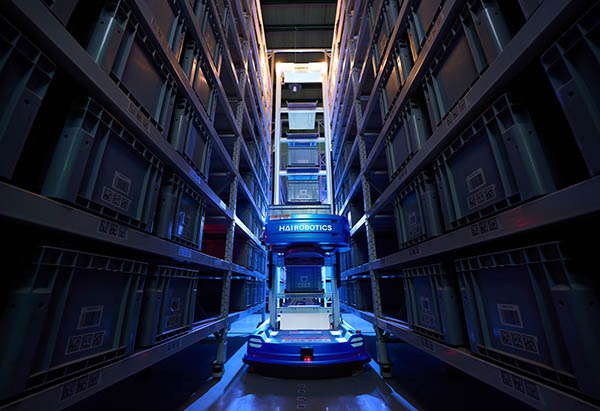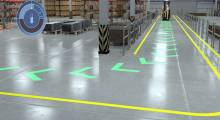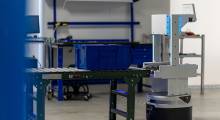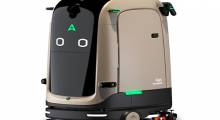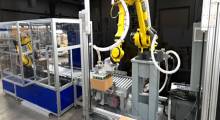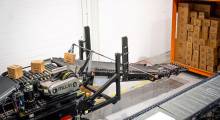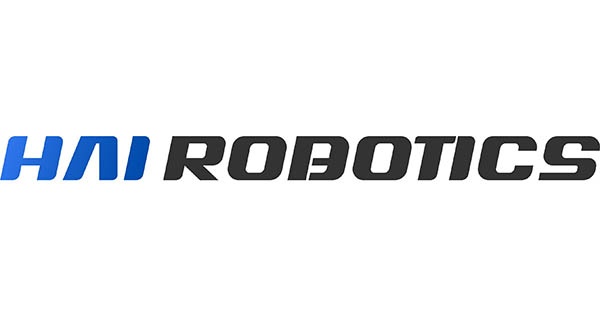WINIT needed to relieve human workers of physical strain and improve efficiency in its U.K. facility. The Shanghai-based operator of warehouses worldwide ultimately turned to autonomous case-handling robots from Shenzhen, China-based HAI Robotics.
With 12 years of experience working in warehousing, Christopher Calderhead never expected that one day he would work with robots. Calderhead has been working in the overseas warehouse of WINIT for about a year now. As an outbound team leader, he makes sure that the system runs smoothly and that orders are fulfilled daily.
“Working in a warehouse is tough, especially manual handling,” said Calderhead. “People usually get sick because of bad backs. There's a lot more locations you have to go to. Therefore there's more walking you have to do.”
“At the end of the day, you just want to go home and relax for the rest of the night because you've been worn out from work manually,” he added. “You don't even have much energy to spend time with your kids.”
WINIT faces demand worldwide
WINIT runs warehousing and distribution services in Australia, the U.S., and several European countries. The total size of its warehouses abroad is about 399,400 sq m (4.2 million sq. ft.), or the size of 56 football pitches (soccer fields). In the U.K. alone, WINIT runs three warehouses, with the total size reaching 50,000 sq. m (538,000 sq. ft.), or seven football pitches.
Over the past two years, demand for global warehousing services surged with the growth of cross-border e-commerce. Custom reports found that in 2021, Chinese cross-border trade volume amounted to RMB1.98 trillion ($290 billion U.S.), up 15% compared to the year before. That volume is expected to reach RMB2.5 trillion ($360 billion) by 2025, according to figures released last year by China.
One major challenge for WINIT is the huge number of SKUs owned by different merchants, which raised concerns about warehouse storage density and picking efficiency. To address this, the company chose HAI Robotics to automate its fulfillment operations.
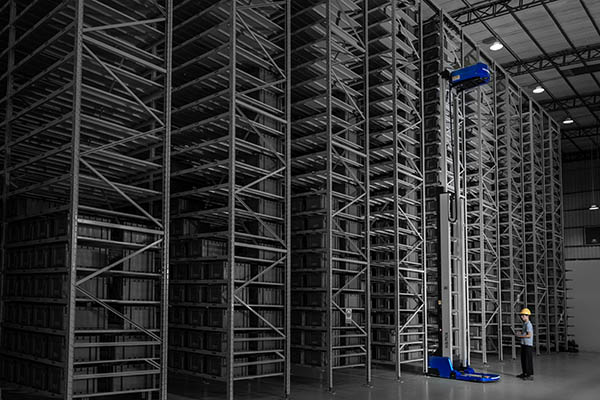
ACR systems promise to increase efficiency
In late 2021 when WINIT began using autonomous case-handling robots (ACRs) from HAI Robotics. The company deployed about 100 robots in its warehouse near Birmingham in the central U.K.
The computer-controlled robots move smoothly in the facility of more than 30,000 sq. m (322,900 sq. ft.) to help workers pick and sort goods. As a result, the WINIT warehouse's efficiency tripled or quadrupled, handling volumes of up to 50,000 pieces daily.
“With the robotic system, we make less mistakes,” said Calderhead. “Because there are clear instructions for each action, and when we pick wrong goods, the system blocks it.”
“And an easy-to-handle process is in place when something unusual happens,” he added. “The system saves a lot of manual effort.”
HAI Robotics does custom deployment
Founded in 2016, HAI Robotics last year raised $200 million to upgrade and grow its warehouse robot fleet. The company customized a plan for WINIT.
The warehouse automation project provides 120,000 storage locations with shelving height of 4.3 m (14.1 ft.) in a 10,000-sq.-m (107,639 sq. ft.) warehouse in Tamworth, Staffordshire.
HAI Robotics is rapidly deploying 100 HAIPICK A42 robots and 16 On-conveyor Picking Workstations in the warehouse. With automated storage and retrieval functions, average efficiency reaches 450 cases per hour, said the company.
WINIT said HAI Robotics' flexible system provides the high storage density, goods-handling accuracy, and operation efficiency to meet soaring demand.
“These smart robots have well met our expectations,” said Bob, who is in charge of the U.K. warehouse. “So far, WINIT has helped more than 3,000 Chinese cross-border merchants export to the U.K.”
“We picked HAI Robotics as our autonomous robot supplier among several other companies because it is one of the first developers,” he said. “Its system has better stability than that of others, and its staff is professional.”
Automation accelerates order fulfillment
Since its project with HAI Robotics went live, WINIT said its warehouse throughput can now accommodate order-fulfillment requests from merchants around the world. The solution has improved storage density by 60% and picking efficiency by 50% in a warehouse with over 100,000 SKUs. The current on-time delivery of WINIT is close to 100%.
WINIT said the COVID-19 pandemic has not affected its overall service and operation, despite global supply chain disruptions, thanks to HAI Robotics' help.
HAIPICK enabled the company to maintain its on-time delivery while ensuring the completion of orders. So far, WINIT has helped more than 20,000 Chinese merchants to export their goods to the U.S., the U.K., Australia, and Europe.
HAIPICK alleviates labor woes
In addition, HAIPICK can let companies significantly reduce labor costs, said HAI Robotics. Not only does it mitigate the need to hire new employees to perform the most labor-intensive, repetitive warehouse work, but it can improve the speed and accuracy with which work is carried out.
“The labor shortage in the U.K. is particularly apparent now,” Bob said. “Brexit and the COVID-19 pandemic have had dire consequences for the warehouse and logistics sector. Experienced employees are leaving, and it’s hard to fill in new ones. As a result, our labor cost, in response, surged too. ”
Worker shortages have led to delivery issues for customers, a loss of income for employers, and ultimately irreversible effects on warehouses. Robots enable allows employees to focus on more important, strategic tasks, as well as retrain and upskill.
Becky, a warehouse staff member, said that with help of the robots, she could stay in the workstation and just wait for them to pick and carry the goods back and forth. She never walks thousands of steps indoors and is free of the pain in her waist.
“Getting the goods now is like getting something at my fingertips,” Becky said. “They make my work much easier. Now I don’t need to move around and bend my waist. ... When I got home after work, I still felt my energy and could eventually spend some valuable time with my children.”
E-commerce continues to drive adoption
By 2024, growing e-commerce sales in the U.K. could require an additional 92 million sq. ft. of warehouse space, according to an analysis by Logistics Business. With the average consumer expecting rapid deliveries of products that are both made to order and easily returned, businesses need robots, it noted.
“Automation has become a key part of boosting warehouse operations,” said the analysis. “This can enhance efficiency, speed, accuracy, and safety. As we look to the future, robots are expected to take center stage. “
Automation is already a significant market, representing over $10 billion in annual global spending. By 2025, over 4 million robots will be installed in more than 50,000 automated warehouses, predicted ABI Research.
Article topics
Email Sign Up

